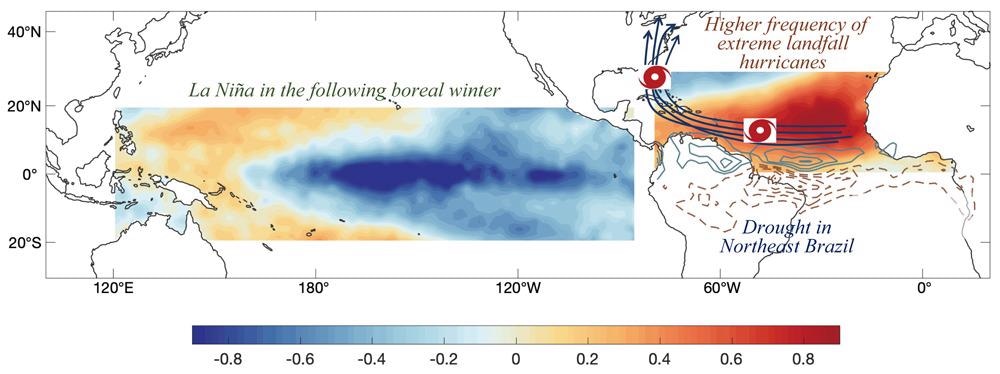Reviewed by Alex SmithAug 26 2021
One of the most consequential and dominant climate variations on Earth are the North Tropical Atlantic (NTA) sea surface temperature anomalies.
 Observed NTA warming events and their impact. Image Credit: Yun Yang.
Observed NTA warming events and their impact. Image Credit: Yun Yang.
NTA warming events cause an increase in the instances of extreme hurricanes and their frequency of landfall along the U.S. East Coast. They cause acute droughts in Northeast Brazil, promote phytoplankton blooms in the Guinea Dome and induce La Niña events the following winter. So far, future variations in NTA variability and mechanisms behind them have remained unknown.
However, a recent study has shown that NTA variability is predicted to increase in a warming climate. The study was performed by an international team constituting 12 researchers from nine institutes across the globe. The findings of the study were reported in the Science Advances journal on August 25th, 2021.
The increase in NTA variability means not only strengthening of sea surface temperature anomalies but also increasing occurrences of extreme NTA events.
Yun Yang, Study Lead Author and Associate Professor, College of Global Change and Earth System Science, Beijing Normal University
The NTA variability increase and instances of extreme events are mainly due to intensification of El Niño-Southern Oscillation (ENSO) influence, such as ENSO-forced Pacific-North American pattern and tropospheric temperature anomalies.
ENSO-forced Pacific-North American pattern is improved in a warming climate due to the eastward shift of ENSO-associated equatorial Pacific convection. This improvement is further intensified by an increase in ENSO variability.
According to Gang Huang, co-author of the study from the Institute of Atmospheric Physics (IAP) of the Chinese Academy of Sciences, “the strengthening of ENSO-induced temperature anomalies is due to combined effects of an increase in ENSO variability and amplified vapor response to ENSO.”
The consequence of an increase in ENSO variability and its teleconnections under greenhouse warming is more severe than previously thought, as the increase can energize dominant modes of climate variability remote from the Pacific, such as the NTA.
Wenju Cai, Study Co-Author, Centre for Southern Hemisphere Oceans Research, CSIRO Oceans and Atmosphere, Australia
In view of the intense climatic impact of NTA in causing floods, droughts and extreme hurricanes, this research adds to the emergent need to reduce greenhouse gas emissions.
Journal Reference:
Yang, Y., et al. (2021) Greenhouse warming intensifies north tropical Atlantic climate variability. Science Advances. doi.org/10.1126/sciadv.abg9690.